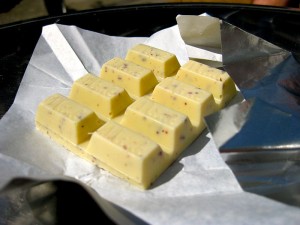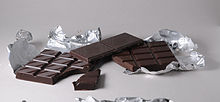Several types of chocolate can be distinguished. Pure, unsweetened chocolate contains primarily cocoa solids and cocoa butter in varying proportions. Much of the chocolate consumed today is in the form of sweet chocolate, combining chocolate with sugar.
Milk Chocolate
Milk chocolate is sweet chocolate that additionally contains milk powder or condensed milk. In the 1870s, Swiss confectioner Daniel Peter had developed solid milk chocolate using condensed milk, but German company Jordan & Timaeus in Dresden, Saxony invented milk chocolate already in 1839; hitherto it had only been available as a drink. The U.S. Government requires a 10% concentration of chocolate liquor. EU regulations specify a minimum of 25% cocoa solids. However, an agreement was reached in 2000 that allowed what by exception from these regulations is called “milk chocolate” in the UK, Ireland, and Malta, containing only 20% cocoa solids, to be traded as “family milk chocolate” elsewhere in the European Union.
White Chocolate
White chocolate contains cocoa butter, sugar, and milk, but no cocoa solids. Chocolate contains alkaloids such as theobromine and phenethylamine, which have some physiological effects in humans, but the presence of theobromine renders it toxic to some animals, such as dogs and cats. It has been linked to serotonin levels in the brain.
White chocolate is formed from a mixture of sugar, cocoa butter and milk solids. Although its texture is similar to milk and dark chocolate, it does not contain any cocoa solids. Because of this, many countries do not consider white chocolate as chocolate at all. Although first introduced by Hebert Candies in 1955, Mars, Incorporated was the first to produce white chocolate within the United States. Because it does not contain any cocoa solids, white chocolate does not contain any theobromine, meaning it can be consumed by animals. It is usually not used for cooking.
Dark Chocolate
Dark chocolate has been promoted for unproven health benefits, as it seems to possess substantial amount of antioxidants that reduce the formation of free radicals. It is produced by adding fat and sugar to the cacao mixture. The U.S. Food and Drug Administration calls this “sweet chocolate,” and requires a 15% concentration of chocolate liquor. European rules specify a minimum of 35% cocoa solids. Dark chocolate, with its high cocoa content, is a rich source of epicatechin and gallic acid, which are thought to possess cardioprotective properties. Dark chocolate has also been said to reduce the possibility of a heart attack when consumed regularly in small amounts. [source: Wikipedia]



